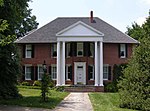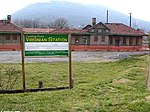Crystal Spring Steam Pumping Station

The Crystal Spring Steam Pumping Station is a historic pumping station located at Roanoke, Virginia, in the United States. It was built in 1905, and is a one-story building constructed in common-bond brick. The building houses a Corliss-type pump made by the Snow Steam Pump Company in Buffalo, New York. At its peak, the pump provided 5,000,000 US gallons (19,000 m3) of water daily. It was in operation from 1905 to 1957, and was an important source of fresh water in Roanoke's early history. The pump and building underwent a renovation in 1976, and the property was listed on the National Register of Historic Places in 1980. As of 2023 the building was open for tours during summer weekends.
Excerpt from the Wikipedia article Crystal Spring Steam Pumping Station (License: CC BY-SA 3.0, Authors, Images).Crystal Spring Steam Pumping Station
South Jefferson Street, Roanoke
Geographical coordinates (GPS) Address Nearby Places Show on map
Geographical coordinates (GPS)
| Latitude | Longitude |
|---|---|
| N 37.249722222222 ° | E -79.944444444444 ° |
Address
South Jefferson Street 2017
24014 Roanoke
Virginia, United States
Open on Google Maps







